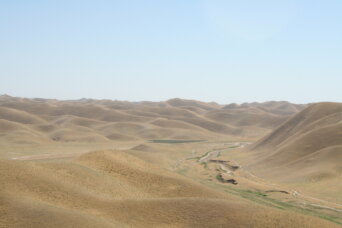- About
- Topics
- Picks
- Audio
- Story
- In-Depth
- Opinion
- News
- Donate
- Signup for our newsletterOur Editors' Best Picks.Send
Read, Debate: Engage.
| topic: | Climate Change |
|---|---|
| located: | Afghanistan |
| editor: | Shadi Khan Saif |
War is not the only cause behind the existential crisis for many in Afghanistan. Being among the least polluting nations on earth with just 0.1 percent of the global greenhouse gas emissions, the country has borne the brunt of climate change recently.
As heads of some of the richest countries were attending the Leaders Summit on Climate hosted by the US President Joe Biden, hundreds of thousands of Afghans in northern parts of the country were still reeling from last year’s unexpected flash floods.
Many more were grappling with drought-like situations in the south, while the miserable plight of those internally displaced by erratic weather patterns remained the same across the country.
According to OCHA services, Afghanistan “faces rates of warming higher than the global average with a potential rise of 1.4°C–5.4°C by the 2080s and the 2090s, compared with the baseline of 1986–2005.”
Seeing as Afghanistan remains among the most vulnerable to climate change, its perspective must never be ignored at such major events that can set the course for the world order in this regard.
This is because the policy decisions made at this Leaders Summit on Climate means a lot when it comes to broad economic benefits of climate action, job creation, the economic benefits of green recovery and long-term de-carbonisation and the importance of ensuring that all communities and workers benefit from the clean-energy transition.
With a renewed devotion to the deep-rooted tradition of tree-planting and conservation, Afghanistan is inching closer to reviving most of its lost forest cover that was destroyed due to war and the timber mafia.
Its agro-based economy - if supported by the international community through scaled-up climate finance and cutting-edge approaches to strengthening resilience in the face of climate change and climate variability - would help address poverty, which is one of the causes for the raging insurgency here.
With its rich lithium deposits to help build batteries, and enormous renewable and clean energy resources, Afghanistan can help tackle the climate crisis provided it receives global support and attention.
Various studies have proven that unlike many developing countries that struggle to identify domestic sources of clean and sustainable energy, Afghanistan has an abundance of hydro, solar, wind and geothermal resources as assets.
It is estimated that with wind speeds exceeding 6.8 m/s, up to 150GW of power can be produced. The country can also potentially produce 220,000MW of solar power as it has some 300 sunny days each year.
Afghanistan does not need charity aid. It should be respected as a partner and taken onboard as a responsible country to not only fight for itself, but for the world in this ‘decisive decade’ for tackling climate change.
Image: Madame Knipse.

